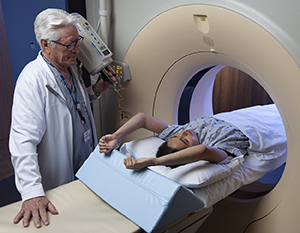Understanding a Low-Dose CT Scan for Lung Cancer Screening
A computed tomography (CT) scan is a type of imaging test. It uses X-rays and a computer to make detailed pictures of your lungs and other soft tissues, organs, blood vessels, and bones. These images are more detailed than regular X-rays and can give information about soft tissues and organs that X-rays cannot. A CT scan exposes you to some radiation as part of the imaging process. The amount of radiation delivered varies by machine, body size, and the imaging protocol. A low-dose CT (LDCT) scan delivers less than a normal CT scan but more than a single X-ray.
In a CT scan, an X-ray beam moves in a circle around your body and can also be called a spiral CT scan. It takes many images of the lungs and inside the chest. A computer processes these images. They are then displayed on a monitor.
Why an LDCT is done
LDCT is used in screening for lung cancer. The goal in screening is to find cancer when it is small and hasn't spread so that it can be surgically removed. This test is useful for the early detection of lung cancer when it’s more likely to be cured. Yearly lung cancer screening with a low-dose CT scan can reduce the risk of dying from lung cancer for those at high risk.
Several expert groups have lung cancer screening guidelines. These include the U.S. Preventive Services Task Force (USPSTF), the American Society of Clinical Oncology, the American Cancer Society, and the National Comprehensive Cancer Network. The guidelines vary a little among expert groups, so talk with your healthcare provider about your risk and situation. The USPSTF advises that people who smoke be screened every year with low-dose CT. Or they should talk with their healthcare provider about yearly screening if they meet all of the following:
-
Are age 50 to 80. (Check with your insurance plan because some plans have age limits.)
-
Are current smokers or have quit within the last 15 years.
-
Have a 20 pack-year history of smoking. A pack-year is 1 pack of cigarettes per day per year. So, 1 pack per day for 20 years or 2 packs per day for 10 years would be 20 pack-years.
The USPSTF says that screening can stop once a person has not smoked for 15 years or has a health problem that limits their life expectancy or their ability to have lung surgery.
Your healthcare provider may have other reasons to advise this test. Expert groups differ slightly in their advice, so talk with your healthcare provider about your risk and situation.
How an LDCT is done
Before the test you will be asked to remove any metal that you are wearing, such as jewelry. You may be asked to wear a hospital gown. A CT scanner is a large, round piece of equipment with a large hole in the center. You will lie on a table that moves through the center of the scanner. The machine rotates around you and makes a whirring noise. You will need to stay very still. You may be asked to take a deep breath. The test is painless. The technician is in the next room and can watch you through a window. They can communicate with you through a two-way intercom.

Risks of an LDCT
-
False positive results. Sometimes this test can show lung nodules that are not cancerous. This can lead to unnecessary biopsies or other tests.
-
Radiation exposure. Although this test uses low-dose radiation compared with a regular CT scan, it uses about 20 times more radiation than a typical chest X-ray.
Talk with your healthcare provider about the benefits and risk of having an LDCT. If you are at high risk, the benefits may be greater than the risks.